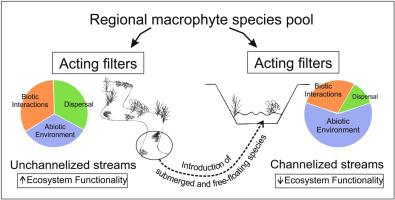Aquatic Botany ( IF 1.9 ) Pub Date : 2021-08-08 , DOI: 10.1016/j.aquabot.2021.103434 L.E. Paz 1 , P. Altieri 2 , A.C. Ferreira 2 , C. Ocon 2 , A. Rodrigues Capítulo 2 , A. Cortelezzi 1

|
In lowland streams, channelization is a severe hydromorphological modification with negative impacts on ecosystem functioning and biological communities. We assessed the functional structure and spatial patterns of macrophyte assemblages in channelized streams, and we identified the most affected traits by this practice. We studied unchannelized (UCS) and channelized sites (CS) using a null model approach and functional diversity indices. The macrophyte coverage was higher in the UCS (mean: 86 ± 15 %) than in the CS (50 ± 35 %). Unchannelized sites revealed a random pattern, with predominating submerged and free-floating species, as well as reproduction by turions and tubers. Channelized sites showed a segregation pattern (C-score obs.: 23.08; C- core exp.: 22.20; SES: 3.20) of functionally similar species indicating interspecific competition, and lower functional richness, evenness, and Rao quadratic entropy compared to the UCS. The predominant traits found for macrophyte assemblages of these sites were emergent life form, and dispersion by stolons. Our results indicate that in CS, the abiotic environment and biotic interactions act as filters and only macrophyte species with key traits can colonize these streams. In this sense, the creation of backwater areas, the reestablishment of longitudinal and lateral connections of the streams, as well as macrophyte transplants could favor the dispersal and establishment of macrophyte species. These rehabilitation measures could positively improve the functionality of these ecosystems.
中文翻译:

渠道化溪流中的大型植物功能性状
在低地溪流中,渠道化是一种严重的水文形态改变,对生态系统功能和生物群落产生负面影响。我们评估了渠道化河流中大型植物组合的功能结构和空间模式,并确定了这种做法影响最大的性状。我们使用空模型方法和功能多样性指数研究了非通道化 (UCS) 和通道化站点 (CS)。UCS 中的大型植物覆盖率(平均值:86±15%)高于 CS(50±35%)。Unchannelized网站显示随机模式,主要是淹没和自由漂浮的物种,以及通过turions和块茎繁殖。通道化位点显示出功能相似物种的分离模式(C-score obs.: 23.08; C-core exp.: 22.20; SES: 3.20),表明种间竞争,与 UCS 相比,函数丰富度、均匀度和 Rao 二次熵较低。在这些地点发现的大型植物组合的主要特征是新出现的生命形式和匍匐茎的扩散。我们的结果表明,在 CS 中,非生物环境和生物相互作用充当过滤器,只有具有关键特征的大型植物物种才能在这些溪流中定居。从这个意义上说,回水区的创建、河流纵向和横向连接的重建以及大型植物移植可能有利于大型植物物种的扩散和建立。这些恢复措施可以积极改善这些生态系统的功能。在这些地点发现的大型植物组合的主要特征是新出现的生命形式和匍匐茎的扩散。我们的结果表明,在 CS 中,非生物环境和生物相互作用充当过滤器,只有具有关键特征的大型植物物种才能在这些溪流中定居。从这个意义上说,回水区的创建、河流纵向和横向连接的重建以及大型植物移植可能有利于大型植物物种的扩散和建立。这些恢复措施可以积极改善这些生态系统的功能。在这些地点发现的大型植物组合的主要特征是新出现的生命形式和匍匐茎的扩散。我们的结果表明,在 CS 中,非生物环境和生物相互作用充当过滤器,只有具有关键特征的大型植物物种才能在这些溪流中定居。从这个意义上说,回水区的创建、河流纵向和横向连接的重建以及大型植物移植可能有利于大型植物物种的扩散和建立。这些恢复措施可以积极改善这些生态系统的功能。建立回水区、重新建立河流的纵向和横向连接以及大型植物移植可能有利于大型植物物种的扩散和建立。这些恢复措施可以积极改善这些生态系统的功能。建立回水区、重新建立河流的纵向和横向连接以及大型植物移植可能有利于大型植物物种的扩散和建立。这些恢复措施可以积极改善这些生态系统的功能。











































 京公网安备 11010802027423号
京公网安备 11010802027423号